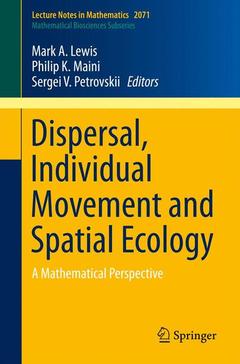Dispersal, Individual Movement and Spatial Ecology, 2013 A Mathematical Perspective Mathematical Biosciences Subseries Series
Langue : Anglais
Coordonnateurs : Lewis Mark A., Maini Philip K., Petrovskii Sergei V.

Dispersal of plants and animals is one of the most fascinating subjects in ecology. It has long been recognized as an important factor affecting ecosystem dynamics. Dispersal is apparently a phenomenon of biological origin; however, because of its complexity, it cannot be studied comprehensively by biological methods alone. Deeper insights into dispersal properties and implications require interdisciplinary approaches involving biologists, ecologists and mathematicians. The purpose of this book is to provide a forum for researches with different backgrounds and expertise and to ensure further advances in the study of dispersal and spatial ecology. This book is unique in its attempt to give an overview of dispersal studies across different spatial scales, such as the scale of individual movement, the population scale and the scale of communities and ecosystems. It is written by top-level experts in the field of dispersal modeling and covers a wide range of problems ranging from the identification of Levy walks in animal movement to the implications of dispersal on an evolutionary timescale.
Part I: Individual Animal Movement.- 1. Stochas-tic optimal foraging theory.- 2. Levy or not? Analysing positional data from animal movement paths.- 3. Beyond optimal searching: Recent developments in the modelling of animal movement patterns as Levy walks.- Part II: From Individuals to Populations.- 4. The mathematical analysis of biological aggregation and dispersal: progress, problems and perspectives.- 5. Hybrid modelling of individual movement and collective behaviour.- 6. From individual movement rules to population level patterns: the case of central-place foragers.- 7. Transport and anisotropic diffusion models for movement in oriented habitats.- 8. Incorporating complex foraging of zooplankton in models: role of micro- and mesoscale processes in macroscale patterns.- Part III: Populations, Communities and Ecosystems.- 9. Life on the move: modeling the effects of climate-driven range shifts with integrodifference equations.- 10. Control of competitive bioinvasion.- 11. Destruction and diversity: effects of habitat loss on ecological communities.- 12. Emergence and propagation of patterns in nonlocal reaction-diffusion equations arising in the theory of speciation.- 13. Numerical study of pest population size at various diffusion rates.
Includes supplementary material: sn.pub/extras
Date de parution : 04-2013
Ouvrage de 385 p.
15.5x23.5 cm
Thème de Dispersal, Individual Movement and Spatial Ecology :
Mots-clés :
Biological invasion; Dispersal; Hybrid modelling; M31000; M13003; L19147; L19007; M13090; M14068; Pattern formation
© 2024 LAVOISIER S.A.S.



